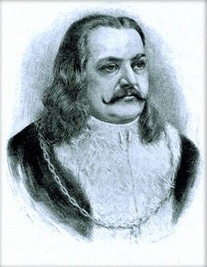
George of Podebrady
He was the only Czech ruler that didn’t come from a royal dynasty, but from local nobility. He is known for his prudent approach and for his idea of a unified Europe, which was ahead of its time and for the purpose of which he organized massive delegations.
He quickly improved his rank within the Hussite nobility branch and soon stood at its head. He seized Prague in 1448 and Tabor in 1452, thus annihilating the radical Hussite wing as a political foe. He made an agreement with Vladislas the Posthumous, and by acknowledging him as king, he became his highest Bohemian administrator. In 1457 the king died of Leukemia and nobody knew who would succeed him. Surprisingly, George of Podebrady was finally chosen. The reason for his being elected was that he guaranteed a relatively conflict-free cohabitation between the Utraquists and the Catholic nobilities, while honoring the Council of Basel (a treaty that permitted communion under both).
George of Podebrady was an excellent diplomat on both the national and especially the international scenes. At home he was able to maintain the delicate balance of an Utraquist majority with a Catholic minority and, simultaneously, to strike sharply against the emerging Unity of the Brethren with few repercussions. Internationally, he tried to skillfully deal with the posture of the other rulers who saw him as an intruder and usurper, while at the same time foreseeing the emerging unavoidable conflict with the Pope.
Thanks to his artful diplomacy he
was able to convince Fredrick III to join his side and, temporarily, King Matthias Corvinus of Hungary. Later, however, George and Matthias had a falling out, partially because of the Hungarian issue and partially due to Matthias’ ambitiousness. Pressure from the Curia grew and George refused to step in fully against the Utraquist majority. As he wasn’t satisfied with passive resistance only, he began to organize active resistance.
He sent delegations to all the major European courts, trying to convince their rulers of his revolutionary idea of a universal peace and common action agreement among all Christian rulers. It was truly a revolutionary idea, which in addition to radically changing the political map would provide joint protection against the Turks. The Pope, however, would have a minimal role in the arrangement and so the Curia both openly and secretly opposed it. And so this bold idea, after much drama, was unsuccessful. It took another 5 centuries before it was carried out.
The king eventually found himself in conflict with home factions and the Pope immediately used this to his advantage, he excommunicated him and announced a crusade against him. The king’s former son-in-law Matthias Corvinus decided to make use of this opportunity, but was eventually defeated and released on his word of honor (which he later broke). George then realized that the time of his rule was coming to an end and so he offered his crown to the Jagiellos. Soon after, the great king was dead.






